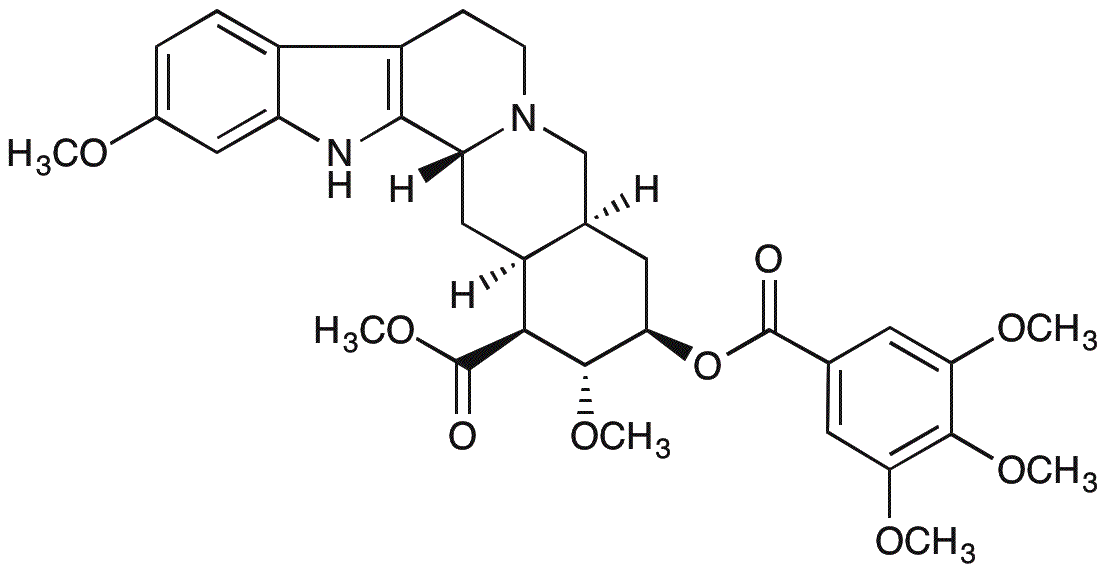Reserpine is widely utilized in research focused on
- Pharmaceutical Development: Reserpine is primarily used in the formulation of antihypertensive medications, helping to lower blood pressure in patients with hypertension.
- Neuroscience Research: It serves as a valuable tool in studies related to neurotransmitter regulation, particularly in understanding the role of serotonin and norepinephrine in mood disorders.
- Animal Behavior Studies: Researchers use reserpine to investigate its effects on animal behavior, particularly in studies related to stress and anxiety, providing insights into potential treatments for similar conditions in humans.
- Traditional Medicine: In some cultures, reserpine is utilized in herbal medicine for its calming effects, showcasing its historical significance and ongoing relevance in alternative therapies.
- Cardiovascular Research: Its application in cardiovascular studies helps in understanding the mechanisms of drug action on heart function, contributing to the development of new therapies for heart diseases.
Informations générales
Propriétés
Sécurité et réglementation
Applications
Reserpine is widely utilized in research focused on
- Pharmaceutical Development: Reserpine is primarily used in the formulation of antihypertensive medications, helping to lower blood pressure in patients with hypertension.
- Neuroscience Research: It serves as a valuable tool in studies related to neurotransmitter regulation, particularly in understanding the role of serotonin and norepinephrine in mood disorders.
- Animal Behavior Studies: Researchers use reserpine to investigate its effects on animal behavior, particularly in studies related to stress and anxiety, providing insights into potential treatments for similar conditions in humans.
- Traditional Medicine: In some cultures, reserpine is utilized in herbal medicine for its calming effects, showcasing its historical significance and ongoing relevance in alternative therapies.
- Cardiovascular Research: Its application in cardiovascular studies helps in understanding the mechanisms of drug action on heart function, contributing to the development of new therapies for heart diseases.
Documents
Fiches de données de sécurité (FDS)
La FDS fournit des informations de sécurité complètes sur la manipulation, le stockage et l’élimination du produit.
Spécifications du produit (PS)
Le PS fournit une description complète des propriétés du produit, notamment sa composition chimique, son état physique, sa pureté et les exigences de stockage. Il détaille également les plages de qualité acceptables et les applications prévues du produit.
Certificats d'analyse (COA)
Recherchez des certificats d'analyse (COA) en saisissant le numéro de lot du produit. Les numéros de lot et de lot se trouvent sur l'étiquette d'un produit, après les mots « Lot » ou « Lot de fabrication ».
Numéro de catalogue
Numéro de lot/série
Certificats d'origine (COO)
Ce certificat d'exploitation confirme le pays dans lequel le produit a été fabriqué, et détaille également les matériaux et composants utilisés et s'il est issu de sources naturelles, synthétiques ou autres sources spécifiques. Ce certificat peut être requis pour les douanes, le commerce et la conformité réglementaire.
Numéro de catalogue
Numéro de lot/série
Fiches de données de sécurité (FDS)
La FDS fournit des informations de sécurité complètes sur la manipulation, le stockage et l’élimination du produit.
DownloadSpécifications du produit (PS)
Le PS fournit une description complète des propriétés du produit, notamment sa composition chimique, son état physique, sa pureté et les exigences de stockage. Il détaille également les plages de qualité acceptables et les applications prévues du produit.
DownloadCertificats d'analyse (COA)
Recherchez des certificats d'analyse (COA) en saisissant le numéro de lot du produit. Les numéros de lot et de lot se trouvent sur l'étiquette d'un produit, après les mots « Lot » ou « Lot de fabrication ».
Numéro de catalogue
Numéro de lot/série
Certificats d'origine (COO)
Ce certificat d'exploitation confirme le pays dans lequel le produit a été fabriqué, et détaille également les matériaux et composants utilisés et s'il est issu de sources naturelles, synthétiques ou autres sources spécifiques. Ce certificat peut être requis pour les douanes, le commerce et la conformité réglementaire.


